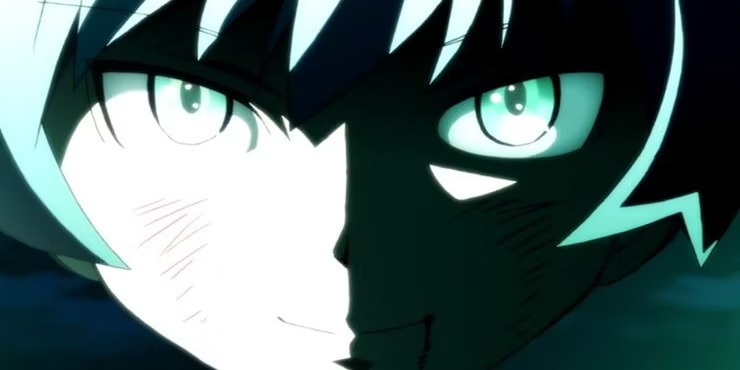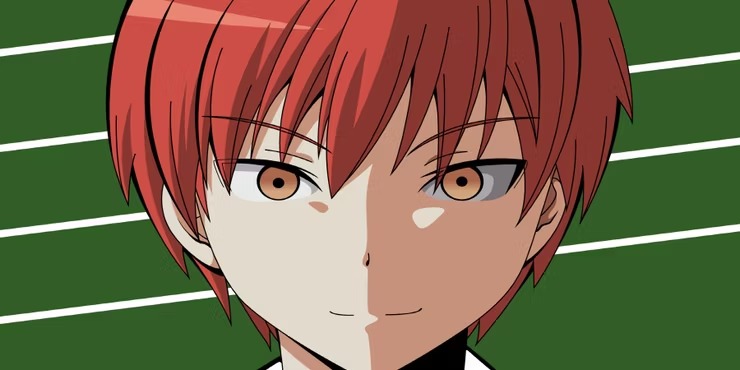The use of real-world color psychology in Assassination Classroom reveals a lot more about the main characters than just their quirky personality traits.

The science fiction comedy anime series Assassination Classroom employs contemporary psychology, particularly color psychology, in the development of its protagonists and plot. Due to its prevalence in the anime industry, characters with bizarre hair colors are frequently overlooked. However, in the case of Assassination Classroom, the series goes above and beyond the norm by concealing major plot twists in order to reveal them.
Assassination Classroom takes place in contemporary Japan at Kunugigaoka Junior High School, an elite school, in collaboration with Yusei Matsui, the original manga artist, and Lerche, the animation brand owned by Studio Hibari.
The show follows Class 3-E, the school’s outcasts, as they attempt to kill Korosensei, an octopus monster that can’t be destroyed and destroyed half of the moon. The anime series, which aired from 2013 to 2016, had two seasons on television, one live-action movie, and a number of Bandai Namco Entertainment video games.
How does color psychology work?

Color psychology can be traced all the way back to ancient Greece, China, and Egypt, where it was discovered that certain colors evoke particular feelings. The foundation for Johann Wolfgang von Goethe’s The Theory of Colors was laid by Isaac Newton’s discovery of wavelengths and the creation of the color wheel. Color psychology as we know it today and its applications in graphic design, therapy, marketing, and advertising is the result of this.
Hair color is one of a person’s most noticeable characteristics. The choice of a person’s hair color may subconsciously link them to a particular emotion or personality trait in the minds of others because hair dye comes in unnatural colors like purple, pink, green, and blue. This is common in anime because many of the main characters are known for their crazy hair colors.
In the case of Assassination Classroom, the audience members and students in Classroom 3-E are the primary targets of this effect, which not only reveals important plot points but also highlights their personality traits.
Korosensei’s Yellow
![]()
As he holds the students of Classroom 3-E hostage, Korosensei is the series’s primary antagonist. Throughout the series, the main question is whether the students in Classroom 3-E can kill Korosensei before he destroys the world at the end of the school year.
However, for such a villainous character, his entire body is bright yellow, a color typically associated with cheerfulness and joy. This is usually the case because, throughout the series, Korosensei is a bubbly, enthusiastic teacher who wants to see his students reach their academic and personal potential to the fullest. However, the negative feelings are also indicative of his character, as yellow can indicate caution and frustration. This is shown in flashbacks to his time as a world-class assassin while he was being experimented on.
Korosensei’s body can change color, unlike the other characters, whose palettes are set. The main character of the show, Nagisa, writes down everything in great detail in one of the episodes, which reveals that Korosensei will subconsciously display visible indicators of his current mood through the color of his body. For instance, stripes with yellow and green represent mockery, pink represents slumber or love, black represents rage, and blue represents sadness.
The students in Classroom 3-E use the change in colors to their advantage when developing assassination plots, so this is crucial to the plot. One illustration of this is when they use an erotic magazine to lure Kurosensei out into the open, giving the students just enough time to stab him with weapons that are against Korosensei.
Nagisa’s Blue

The main character of the series, Nagisa Shiota, is shown to have two sides to him.In addition to the color of his hair, eyes, and clothing, his character design features light blue tones. Peace, tranquility, stability, and trust are the positive emotions associated with blue, according to Rasmussen University. On the other hand, sadness and distance are the negative emotions associated with blue.
When Nagisa first meets him, he seems to have a very understated presence. He is treated like a coward in Classroom 3-E, and he usually acts as a peacemaker. When he executes the first of many failed assassination plots, he quickly demonstrates his inherent abilities. The bullies in Classroom 3-E use him as bait and an anti-Korosensei knife to force him to wear and blow up a grenade with anti-Korosensei bullets around his neck.
Later in the series, he uses his unnatural ability to keep extreme levels of calm and stability to fool his opponents into thinking they are safe and take advantage of their confusion. Dealing with his verbally abusive mother, who controls every aspect of his life, gave him this ability. As he is able to discern the emotions of other people based on the slight variance in frequency in their speech, he develops this ability and makes it spectacular. An assassin’s crucial strength turned out to be years of practice in a stressful environment.
Karma’s Red

The series’ deuteragonist, Karma Akabane, possesses a dual nature as well. Although his dual sides are more obvious than Nagisa’s, their nature does tend to be more extreme. Karma’s character design has orange and red tones, particularly in his eye color and hair color. Rasmussen University says that reds and oranges show positive feelings like passion, warmth, excitement, and enthusiasm. In contrast, rage and danger are the negative emotions that are depicted.
When Karma first appears, he is a violent troublemaker who has just been released from a school suspension for assaulting students in his previous classroom. His anger was the primary reason he was demoted to Classroom 3-E. Later in the series, his character is more developed, and he shows signs of deeply caring for his classmates in roundabout ways and overcomes the hurdle of not wanting to try for fear of failing.
It is later revealed that he had been misguided by his teacher, who allowed the behavior as long as he did well in school. He is passionate about the things and activities he enjoys, in contrast to what he appears to be on the outside. And the positive qualities he was developing overcame the negative aspects of his character that prevented him from succeeding academically.
Kayano’s Green

Kaede Kayano’s identity as Akari Yukimura, the younger sister of the original Classroom 3-E teacher, was revealed to be one of the anime’s biggest plot twists. Kayano’s personality is based on an advanced form of method acting, making her the most extreme of the series’ multifaceted characters. It’s so realistic that even she can’t tell at some point whether she’s Kaede Kayano or Akari Yukimura.
The character design of Kaede Kayano emphasizes greens and yellows, particularly in her eye color and hair color. According to Rasmussen University, the colors green and yellow convey positive feelings like being at one with nature, being calming, and being cheerful; In contrast, the majority of the negative emotions depicted are jealousy, rage, and frustration. These traits perfectly complement Kayano’s character, as she collaborates with the Japanese government on a separate assassination plot.
She is shown to be a positive, people-loving character who just wants everyone to be happy and have a good time when she is first introduced in the series. She is also very creative because she is frequently the main person who organizes and sets up Classroom 3-E’s assassination plots. For instance, in one episode, she tries to blow up Korosensei with bombs that are hidden in a huge pudding container outside the classroom.
Despite her failure, she is able to strengthen her connections with her classmates and satisfy her sweet tooth.
Kaede Kayano, her public persona, is a direct imitation of the positive feelings that come with her character’s design; Akira Yukimura, on the other hand, is a direct representation of the negative emotions she feels as a result of her misplaced hatred for Korosensei, whom she believes killed her older sister before classes began in the fall.
The characters in Assassination Classroom range from simple tropes to complex traits and cover a wide range of unique characters. The audience can at least make some generalizations based on the main characters and how their color schemes and designs reveal relevant information to the overarching plot, even though the application of color psychology may not be a one-to-one link to all of the characters from the anime series.
Always be Updated with us visit GeeksULTD for Real-time Updates





